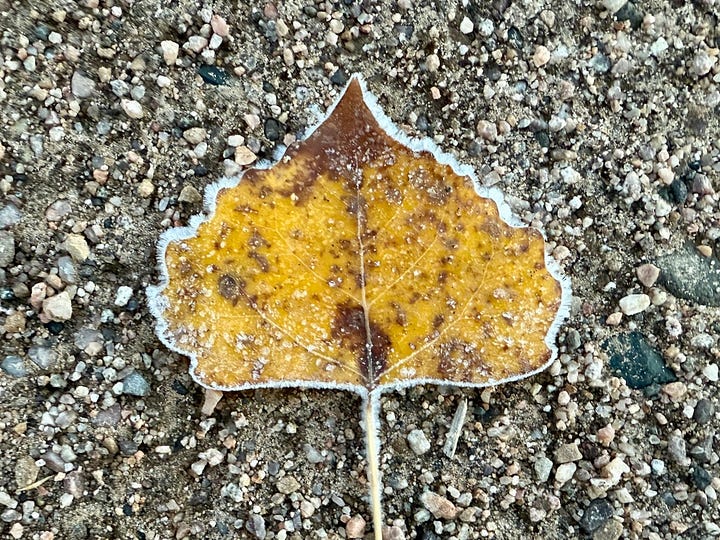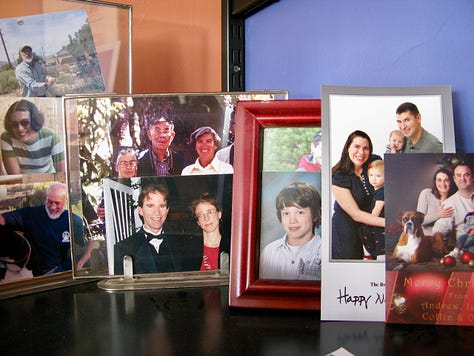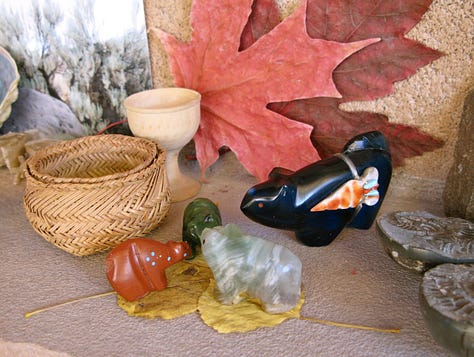You shall not be overcome.
—Julian of Norwich, medieval mystic and author, from Revelations of Divine Love, the first-known book written by a woman in English
Hello Friends, and Happy Halloween, Samhain & Dia del Muerto eve, and Diwali!
It’s a fraught time in our country, and that makes it hard to focus on anything besides worrying about the election and its aftermath. When I find myself spiraling into anxiety, I head outside into nearby nature to walk and let the community of the land ease my mind.
That’s what I did this morning, leaving the cabin in the half-dark of a frosty pre-dawn and walking my three-mile loop along the river until the sun rose. The night’s low of 25 degrees F combined with yesterday’s rain and wet snow left the ground silvered by frost, just one of the gifts of that cold walk.
As my hands grew numb in their warm gloves (that’s Raynaud’s, a circulatory efficiency syndrome that withdraws the blood flow from my extremities when I get cold or stressed), I kept walking, buoyed by other gifts: The peach and copper-infused sunrise (photo at the beginning of the post). The subtle camphor and jasmine fragrance of big sagebrush leaves drenched by yesterday’s moisture. The adult bald eagle flying low down the river, and the amber Fremont cottonwood leaves frozen into ice and frost-bejeweled.


By the time I finished my loop and returned to the cabin, my mind was calm, my body pleasantly relaxed and I was ready for breakfast and the day.
Altars and Festivals
Today is Halloween (All Hallows Eve) in the Christian calendar; tomorrow is both the Celtic Samhain and Dia del Muerto, and this weekend opens Diwali, the festival of light, for many people of Indian heritage.
The four holidays are celebrated in different ways in different places, but all share a link to the turning of the seasons, the transition (in the Northern Hemisphere) from summer’s abundance to winter’s shorter days and longer nights, the reflective time of year.
Halloween, Samhain (pronounced SOW-en) and Dia del Muerto have components of honoring those who are no longer with us, whether our human ancestors, those spirits we believe in, or other beings important to us. Sue Kusch of Fifteen Years and Counting offers an illuminating summary of the three holidays and their relationship to each other:
Samhain
I celebrate Samhain, and my practices are influenced by years of living in the Southwest with the Dia del Muerto celebrations. Which is why I build an altar for Samhain including photos of my beloveds (those still here and those gone on), plus mementoes representing the land where I live and other places that are special to me.
My altars include photos, dried leaves, flowers and branches, animalitos and fetishes, and other representations of those lives and places I want to honor in this time when the veil between this world and the next is more porous, a time when dreams and visions and conversations can be more powerful and vivid.






Altars can come in many forms, from a simple collection of photos and mementoes to elaborately decorated displays. They can draw on many kinds of materials, whether natural or realistic, humorous or edible. They can be permanent installations or ephemeral ones intended to last only a few hours, like the leaves and flowers of Stephanie Raffelock's morning altars practice in this post on her Creative Eldering newsletter:
Witnessing What We Love
The purpose of building an altar for me is simply to stop and reflect on who and what I love, and to assemble a collection of objects that honor that love.
This Samhain, I have been feeling bereft because the photos, fetishes, shells, special rocks and coins and baskets that I normally use to assemble my altar are carefully wrapped in recycled paper and packed in boxes in my storage unit, waiting for me to move into my new house.
As I walked this morning, I reminded myself that I can remember my loved ones without seeing their photos, and I can honor the land I love and the plants and other species who are special to me simply by witnessing their presence in this place.
I can hear the river, smell the big sagebrush, stroke the furrowed bark of the grandmother cottonwood trees, call to the cranes as they pass overhead.

Perhaps most importantly, I can honor all that I love by continuing to work to add to the ocean of light and love in this world, helping overcome the ocean of darkness and fear. Which brings me to Diwali, the festival of lights which many believe celebrates the spiritual victory of Dharma over Adharma, light over darkness.
And there is my hope for us all: That we work together in this fraught time, as the wheel of the year turns, to bring this country and the world into the light of compassion, love and kindness. Take heart from Julian of Norwich’s words: You shall not be overcome.
Working together, we shall indeed not. Please join me!
Blessings, Susan






This is a beautiful post. I can sense your sadness interwoven with your hope. And the new setting there will be just as beautiful to walk in every morning. I’m Celebrating that we finally had .6 in of rain last night after two months with nothing. I had a sleepless night and so the comfort of that gentle rain all night long kept me going in spite of pain, looking forward to morning.
We shall not be overcome. Especially now. Love this potent reminder.
I like to bring in pieces of nature indoors in every season. I noticed on my walk yesterday the sounds of fall—the crunching leaves. What a wonderful crackling sound I could make with the instrument of my feet, and the lift and sounds of the wind.